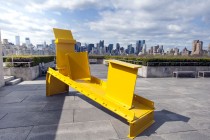A Hidden Gem on New York’s Renowned Rooftop Garden
New York City’s rooftops are known to hold hidden marvels inside their skyline borders. From elevated organic gardens and bars to Antony Gormley’s human sculptures, and even a Rooftop Film Festival, the sky is the limit for many imaginative New Yorker’s. Sitting atop the Metropolitan Museum of Art is one such wonder; an installation of five colorful sculptures by renowned British sculpture artist, Anthony Caro.
Made primarily out of steel, the Anthony Caro on the Roof exhibition is an introspective look into diverse channels of communication between sculpture and architectural space. In fact, according to Anne Strauss, curator at the MET, the setting is meant to reflect a dialogue between the artistic creations and the backdrop of the city.
“The roof garden’s setting provides a dramatic backdrop for featuring this presentation of the work of a distinguished artist who has played a pivotal role in the development of modern sculpture for more than half a century. The abstract works engage with the architectural backdrop of the Manhattan skyline,” she said.
According to Strauss, the exhibit is a one-of-a-kind “career-spanning survey,” that celebrates the artist’s 50th anniversary of his first exhibit of steel sculpture.
“What is unusual about this roof garden exhibition, compared to its thirteen predecessors, is the number of years it spans — fifty years from 1960 to 2010,” Strauss said.
Among the five pieces stands a grandiose, steel-rusted model that resembles a broken cubicle with a gap for a window. The sculpture, End Up, is the fifth piece in the exhibition, and the only one that is made out of three different materials: steel, cast iron, and jarrah wood.
Still, there is no singular meaning behind it, at least not one that has been left exclusively by the artist. And according to Strauss, this was done with intention by Caro, who relishes in the vast and winding journey of exploration and analysis that he leaves solely up to the viewer.
“As is the case with most of Caro’s work, End Up is an abstract work which the viewer is invited to interpret freely. The artist does not seek to impose an interpretation or explanation, leaving that to the viewer,” she said.
Yet according to Strauss, though the meaning behind each work is left intentionally undeclared by the artist, the stories and features behind them, give a hint of what Caro might have had in mind when creating the structures.
For instance, according to Strauss, End Up is “a celebration of found objects that Caro frequently incorporates in his work.”
“Each work has its own standout characteristics. Midday — poetic simplicity with the possible reference to a reclining figure. After Summer — largest work from the 1960s. Odalisque — greater complexity representative of Caro’s later work. Blazon — references to architecture, a specific lodestar for the artist,” she added.
Moreover, the silver, frosted-like, After Summer possesses several elements that come from an extensive collection of raw materials acquired by Caro from the Estate of American sculptor David Smith. According to Strauss, the two artists were acquainted with one another in 1959 during Caro’s first visit to the United States, and had kept in touch over the years.
Drawing in hundreds of viewers on a near daily basis, the exhibition is both an enticing and unforeseen voyage into the mindset and creativity of a man who has left his mark on the art world of today, and will continue to do so even long after his departure from the craft.
“Even after fifty years a distinguished artist’s work can be full of innovation and surprise. The Museum strives to present art of the highest level of achievement over the past 5,000 years of artistic creation,” Strauss concluded.
The exhibition will be on display till October 30, 2011. For more information on the exhibition, including visiting hours, please visit the museum’s Web site at http://www.metmuseum.org


